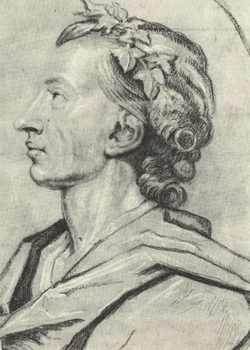|
|
|
|
|
|
|
|
|
|
|
|
|
|
|
|
|
 |
 |
 |
 |
 |
 |
|||||||
|
|
|||||||||||||
|
|
 |
 |
 |
 |
 |
 |
 |
||||||

This collage summarizes the main points raised previously. First of all, not only is Pope’s attention to his body exaggerated but also the image reveals an absurd incongruity between his attempt to impose a perfect vision of himself and the actual fragility of his body. Pope wants to hide his deformity, maybe not realizing that being human is by definition being in one way or another distorted, not ideal and as a result - a caricature. Moreover, his inherent fear of the female literary Grub Street production is grotesquely exposed through the fusion of Pope’s profile bust and Eliza Haywood’s body. Above all, this grotesque collage reflects Pope’s merging gender lines. Since the grotesque is interconnected with the distortion of the natural into a caricature, the collage presents a caricature of Pope which brings together fear and reality, thus blurring the feminine and masculine boundaries. His attempt to relegate women’s writing to the shade of his own writing, brings about a different result. He actually serves women by stimulating proliferation of feminine literature. Women follow Pope into the marketplace either criticizing or imitating his writing. Thus, Pope may be considered as an important figure in women’s literary history - the two opposite forces: female and male in terms of writing become complementary in the process of the feminization of literary production